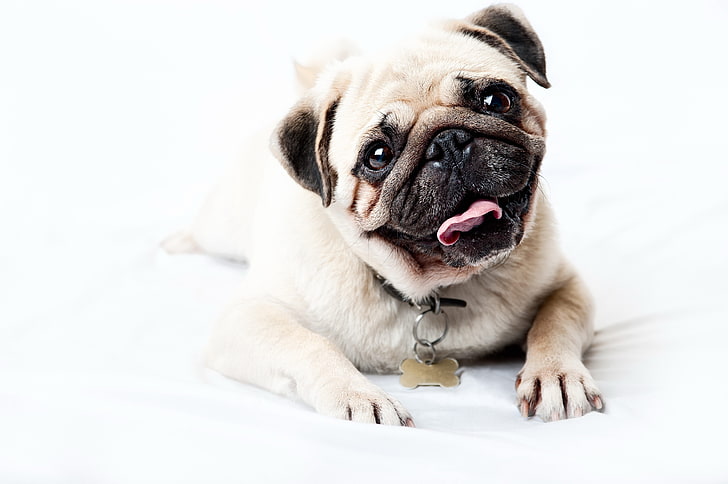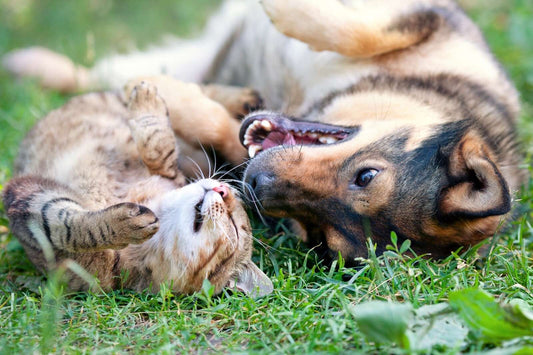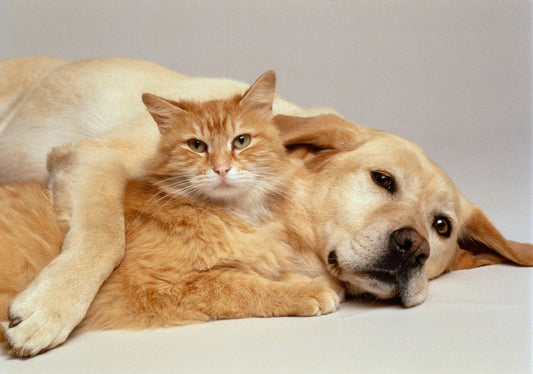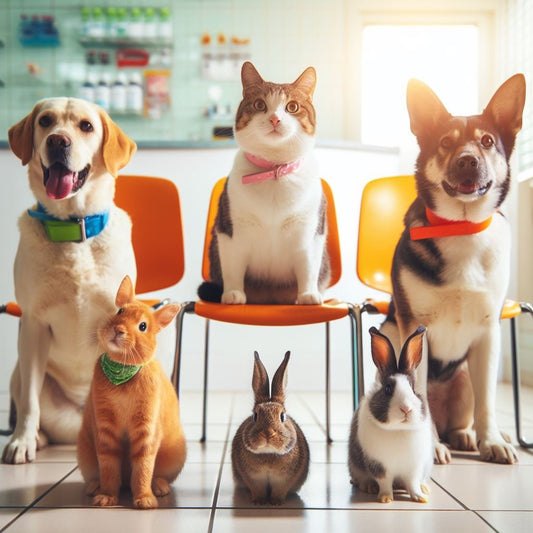With their squished, expressive faces, stocky bodies, and lovable personalities, Pugs are adored by everyone! Originally treasured by Chinese emperors, these even-tempered dogs make loyal buddies. While compact, Pugs boast oversized personalities and live to entertain their humans. With moderate exercise needs, Pugs are well-suited to apartment life. Their wrinkly mugs and silly nature ensure these “Multum in Parvo” dogs deliver endless smiles in small packages.
At A Glance:
Lifespan: 13-15 years
Size: Small to Medium
Temperament: Charming, Clownish, Outgoing, Affectionate, Loyal
Coat: Short, smooth, fawn or black
Best for: Singles, seniors, families; suitable for apartment living
Characteristic |
Pug |
|---|---|
| Affectionate Level | Extremely affectionate; true “velcro” dogs |
| Friendliness | Very friendly with everyone; stranger danger unaware |
| Exercise Needs | Moderate; some daily walks and indoor play |
| Training | Food motivated and willing to please; can be stubborn |
| Grooming | Minimal shedding. Short, smooth coat requires weekly brushing; wrinkle cleaning |

History:
The origins of the charming pug stretch back to ancient China, where they were treasured by emperors and royal families alike. These clever clowns likely descended from short-muzzled breeds like the lovable Pekingese, though they eventually developed their own distinct squishy-faced appearance and playful personality.
By the 1500s, Dutch traders first transported some of these squishy pets back to Europe, where they became favoured lapdogs by the aristocracy. Their popularity as comical companions continued spreading across continents over the next centuries; Napoleon and Queen Victoria were both fascinated by these loyal and bug-eyed companions.
Due to their petite size and easygoing attitude, pugs have been popular apartment pets since the 19th century. Today, these amicable dogs delight children and adults everywhere with their "nose wrinkles" and silly antics. Although small in stature, pugs radiate warmth with their twinkling eyes and smiles that never fail to fill the room.
Breed Appearance:
Pugs boast muscular little bodies supported by straight tiny legs, with curly little tails. Their glossy short coats come in hues of fawn or black, accompanied by a single parading ribbon down their adorable little backs.
But the pug's most memorable feature has to be that beautifully smushed face! They are a brachycephalic breed, which translates to flat-faced dogs. Their sizable eyes are set apart and bulge out endearingly above a short muzzle. They have a slight underbite that adds to their look. Floppy rose-shaped ears frame their faces, whether they stand alert or relaxed.
Pug Temperament:
Pugs burst with larger-than-life personalities despite their pint-sized bodies! These natural comedians thrive on making their people smile with their affectionate antics and goofy grins. Clever and observant, Pugs often perceive themselves as mighty guardians of the home, bravely "protecting" their family from suspicious noises and guests.
But any stranger is only one belly rub away from becoming a pug's next new best friend! They love meeting new faces to entertain and shower with snuggles. Beyond the silliness, pugs are also amazing nap takers and cuddlers, feeling most content snoozing blissfully in their favourite lap.
With their family is where a pug really comes alive - following everywhere with great enthusiasm. Their attention craves constant togetherness and playfulness. Short walks or games of fetch satisfy their moderate exercise needs so the rest of the day can be spent "helping" with household tasks and supervisor snuggles.
Caring For A Pug:
Diet & Nutrition:
Pugs have a huge appetite and absolutely love to eat! Which is why, it’s essential to monitor their food intake. These hungry hounds' magical ability to turn anything into calories must not be overused! Pugs require a balanced nutritional diet of quality dog food recommended for their age and weight. Serving size should reflect their maturity and activity level - younger or very lively pugs have higher needs. As older adults, they become prone to obesity so portion control is important. Canned or dry kibbles work well as bases for a pug’s diet with healthy tidbits like vegetables or lean proteins mixed in moderately. Avoid giving in to their eager appetite with too many fatty scraps or table food. A consistently measured, nutritious diet supports all pugs feeling (and looking) fabulous!
Training:
Smart and highly food-motivated, most pugs take happily to training for an extra chance to munch (and they love to please their humans!). Positive reinforcement with excited praise and tasty treats make lessons fun rather than frustrating. Housetraining may require extra patience since pugs develop slower physically. Crate-training assists by tapping into their natural reluctance to soil their sleeping space. Socialisation from early on ensures Pugs gain exposure to confident adulthood interactions. Keep training upbeat with many short sessions; their loving nature predisposes them to obedience when it satisfyingly fills their bellies and people time quota!
Health:
Due to their scrunched anatomy, Pugs can be prone to certain health conditions. Responsible breeders carefully screen breeding dogs for issues like hip dysplasia, knee problems, eye diseases, respiratory challenges, and Pug Dog Encephalitis (PDE) - a neurological condition specific to pugs. Still, wise pet parents monitor for signs of any emerging conditions over a Pug’s lifetime. Maintaining lean body condition and ensuring proper exercise protects Pug joints as they age. Their facial folds must stay clean to prevent infections; cooling jackets can also prevent overheating. Thanks to excellent veterinary care, many pugs today lead quite healthy lives into their teens though they remain susceptible to obesity and pneumonia. Catching problems early and controlling weight allows these sweet companions the best opportunity to thrive.
Grooming & Maintenance:
Fortunately, Pugs require only occasional grooming to keep their fine, glossy coats at their best! Regular brushing easily removes dead hair while distributing natural oils for extra shine. Nail trims maintain comfortable, safe length. Pugs produce a good deal of wax inside distinctive deep-set ears so gentle weekly cleanings prevent infection-causing buildup. Those cute face wrinkles also demand careful attention – wiping debris away and then keeping it dry avoids irritation in Pug folds. Bath puggies only when truly dirty since over-bathing irritates their sensitive skin. When needed, use a gentle dog shampoo followed by thorough drying.
FAQs:
Do Pugs have a lot of health problems?
Due to their brachycephalic anatomy, Pugs can be prone to certain conditions. Issues like hip dysplasia, eye diseases, and respiratory challenges are common among this breed, especially due to their flat faces. Regular vet visits will ensure early problem detection. Many Pugs today live healthy, happy lives into their teens.
Are Pugs good with kids?
Absolutely! Pugs adore children and are gentle, patient playmates. They enjoy kids' energy, silly games, and snuggles. As family dogs, they instinctively adjust interaction based on a child’s age and needs while modelling good manners. With early socialization and supervision, Pugs excel at entertaining the little ones.
Are they good apartment dogs?
With moderate exercise needs, Pugs adapt excellently to apartment living. A short neighbourhood stroll or lively indoor play session keeps them fit and fulfilled. They thrive on bonding and relish napping near their favourite people. Minimal grooming and shedding also make Pugs ideal for close quarters.











